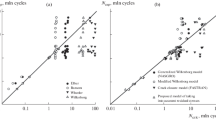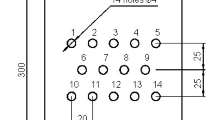Abstract
The fatigue crack growth kinetics in a 2024-T3 aluminum alloy during constant- and variable-amplitude loading a various stress ratios in the medium-amplitude segment of a fatigue crack growth rate curve is studied. Variable-amplitude loading is represented by quasi-random samples of standard random loading spectra, which were preliminarily schematized using a rainflow algorithm. Parameters are proposed to estimate the character of random loading. The influence of the character of random loading using various standard spectra on the fatigue crack growth rate is analyzed. The fatigue crack growth time is estimated with allowance for fatigue crack closure and the character of random loading using a proposed formula and a cycle-by-cycle calculation method.




Similar content being viewed by others
REFERENCES
D. Kocanda, S. Kocanda, and J. Torzewski, “Variable amplitude load interaction in fatigue crack growth for 2024-N3 aluminum alloy,” in Proceedings of 16th European Conference of Fracture (Springer, 2006), pp. 177–178.
J. Schijve, M. Scorupa, A. Scorupa, T. Machniewicz, and P. Gruszczynski, “Fatigue crack growth in the aluminum alloy D16 under constant and variable amplitude loading,” Int. J. Fatigue 26 (1), 1–15 (2004).
C. Q. Bowles, “The role of environment, frequency and wave shape during fatigue crack growth in aluminum alloys,” PhD Thesis, Delft University of Technology, Netherlands, 1978.
A. Hartman and J. Schijve, “The effects of environment and load frequency on the crack propagation law for macro fatigue crack growth in aluminum alloys,” Eng. Fract. Mech. 4 (1), 615–631 (1970).
C. M. Manjunatha, “Fatigue crack growth prediction under spectrum load sequence in an aluminum alloy by K*-RMS approach,” Int. J. Damage Mech. 17 (6), 477–492 (2008).
A. N. Savkin, R. Sunder, D. S. Denisevich, A. A. Sedov, and K. A. Badikov, “Crack growth time estimated with allowance for the interaction of the loading amplitudes,” Izv. VolgGTU, No. 6 (229), 35–39 (2019).
A. N. Savkin, A. V. Andronik, K. A. Badikov, and A. A. Sedov, “Effect of the character of loading and the force parameters of random external action on the fatigue crack growth in a low-alloy steel,” Deform. Razrushenie Mater., No. 7, 40–45 (2017).
A. N. Savkin, K. A. Badikov, and A. A. Sedov, “Fracture toughness of a 2024 aluminum alloy during cyclic constant amplitude loading with various perturbation actions,” Deform. Razrushenie Mater., No. 6, 12–19 (2018).
A. N. Savkin, R. Sunder, K. A. Badikov, and A. A. Sedov, “Kinetics and time of fatigue crack growth in steels during alternating loading,” Vestn. PNIPU, Mekhanika, No. 3, 61–70 (2018).
N. A. Makhutov, Resistance of the Materials of Constructions to Brittle Fracture (Mashinostroenie, Moscow, 1983).
S. D. Downing and D. F. Socie, “Simple rainflow counting algorithms,” Int. J. Fatigue 4 (1), 76–82 (1982).
A. N. Savkin and V. P. Bagmutov, Prediction of the Fatigue Life of Highly Loaded Structures (VolgGTU, Volgograd, 2013).
P. C. Paris and F. Erdogan, “A critical analysis of crack propagation laws,” J. Basic Eng. Trans. ASME. Ser. D 85, 528–534 (1963).
W. Elber, “The significance of fatigue crack closure,” in Damage Tolerance in Aircraft Structures (ASTM Int., Philadelphia, 1971), pp. 230–242.
A. N. Savkin, K. A. Badikov, A. A. Sedov, and A. O. Doluda, “Program for calculating the completeness of constant amplitude loading with perturbation actions,” RF Certificate 2017619354, 2017.
A. N. Savkin, A. V. Andronik, K. A. Badikov, and A. A. Sedov, “Estimation of the completeness of loading of a low-alloy automotive steel under overloading and underloading conditions,” Izv. VolgGTU, No. 9 (188), 79–83 (2016).
A. N. Savkin, A. V. Andronik, and R. Koraddi, “Approximation algorithms of crack growth rate curve based on crack size variations,” J. Test. Eval. 44 (1), 310–319 (2016).
Funding
This work was supported by the Russian Foundation for Basic Research, project no. 17-08-01648 A.
Author information
Authors and Affiliations
Corresponding author
Additional information
Translated by K. Shakhlevich
Rights and permissions
About this article
Cite this article
Savkin, A.N., Sunder, R., Sedov, A.A. et al. Fatigue Crack Growth Kinetics in a 2024-T3 Aluminum Alloy during Alternating Cyclic Loading. Russ. Metall. 2020, 500–505 (2020). https://doi.org/10.1134/S0036029520040254
Received:
Revised:
Accepted:
Published:
Issue Date:
DOI: https://doi.org/10.1134/S0036029520040254




